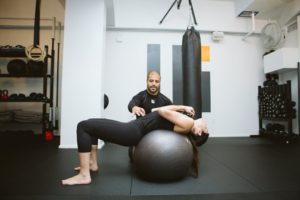Back Injury – How You did it
Poor Form Executing a squat or deadlift while bending or turning your spine has intense effects on shear loading of the discs and the result is back injury. The spine is greatly stronger and better able to survive compressive powers —about 55% stronger—when in a neutral position. Myoelectric signals (electrical signals that control muscles) produce muscle forces when executing the deadlift and squat. With a stretched, curved spine, the muscles of your lower back are “silent,” and you raise strain on next passive tissues and high shearing strengths on the lumbar spine resulting in back injury.
On the other hand, a neutral spine showed better myoelectric lower back muscle recruitment and a reduction of shear forces on the lumbar vertebral disks resulting in a quality lift and decreased risk for wound. Lack of Flexibility Crossed Pelvis Syndrome and Gluteal Amnesia is explained by having weak, weak abdominals, tight hamstrings. When attempting to do squat or deadlift, you will not be able to engage the power muscles of their hips properly, affecting increased stress and force onto your spine.
Training Program
Exercise 1: Cat Camel
- Get down on your hands and knees on the ground.
- Calm down your head, and allow it to droop.
- Round your back up near the ceiling until you feel a fine stretch in your upper, middle, and lower back.
- Grasp this stretch for as long as it feels relaxed or about 15 to 30 seconds.
- Return to the initial position with a flat back while you are on all fours.
- Allow your back sway by pressing your stomach toward the floor.
- Hold for 15 to 30 seconds at this position.
- Repeat 2 to 4 times.

Exercise 2: Bird Dogs
- For the fundamental bird dog, start out with your hands directly beneath your shoulders and knees under your hips, developing a box with 90 degree angles.
- Even in the relaxing position, you should attempt to stiffen your core, while retaining your shoulders down and back away from your ears.
- At the top position, retain your arm and leg in line and be certain not to elevate your head upward. Keep your head in a unbiased place to reduce stress on your neck.

Exercise 3: Clam Shells
- Rest on your side, with both legs twisted.
- Position ankle weight around your thigh, just beyond the knee.
- Execute the workout by keeping your feet together and lifting your upper knee to the upper limit.
- Do 30 reps each side, constricting your glute.
- Then change sides.

Exercise 4: Chin Tucks into Physioball
- Rest on a seat on your back with just your head relaxing off onto a physioball.
- Retaining your head in a neutral position, do a chin tuck.
- Pause for a 1 second hold, then rest and repeat for a sequence of 10 reps.

Submit your review | |

![Best 5 Health Supplement Website Online in India [2018] best health supplement website](http://www.vitaminhaat.in/wp-content/uploads/2018/08/best-health-supplements-websites-218x150.jpg)






















